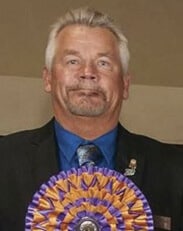Interview with Working Group Judge Jim Taylor
Where do I live? How many years in dogs? How many years as a judge?
Jim Taylor: We live in Grand Blanc, Michigan. I’ve had dogs all of my life, but I bought our first AKC registered Akita in 1974. I’ve been judging since 1999.
What is my original breed? What is/was my kennel name?
Jim Taylor: Akitas were our original bred. Our kennel name is Tora Akitas, after our first Akita.
Can I list a few of the notable dogs I’ve bred? Any performance or parent club titles?
Jim Taylor: Our foundation bitch, Am./Can. CH Tora’s Michiko O Ryan TT, ROMPX, is still tied for producing the most AKC champions. “Michiko” was bred by Rita J. Biddle, Esq. BIS An./Can. CH Momo Saku ROMP was the #1 Akita Bitch in 1995/1996 and #4 overall. Am./Can. CH Tora’s Yuri was the # 1 Akita Bitch in 1993/94; BISS Am./Can. CH We Missed Miss Saigon; Am./Can. CH. Tora’s Hyoga Hazumi. We’ve had generations of Register of Merit Akitas.
What are the qualities I most admire in the Working breeds?
Jim Taylor: Their Strength and Loyalty.
Have I judged any Working Group Specialties?
Jim Taylor: In 2013, I had the honor to judge the Akita National Specialty in Denver, Colorado.
We flew from there to Oconomowoc, Wisconsin, where I showed my Alaskan Malamute bitch, “Martina,” and won the National and Top 20. What a week! I’ve also judged the American Akita National Specialty in Moscow, the Anatolian National Specialty, and the Alaskan Malamute, Greater Swiss, Newfoundland, Kuvasz, St. Bernard, Siberian Husky, Samoyed, Great Dane, Leonberger, and Neapolitan Mastiff Specialties, just to name a few.
Do I find that size, proportion and substance are correct in most Working breeds?
Jim Taylor: Overall, I am satisfied. I think that the standards are specific enough in regard to size/height. There are obvious standouts, with correct proportion and substance. I think that proportion seems to be the hardest for the breeders to breed to. I am a carpenter/contractor by trade. I measure things every day. Proportion is one of my “things.” I also played sports all my life. You probably don’t want to bring me a fat, or snipey, unathletic Working Dog. They MUST be able to do their job!
Is breed-specific presentation important to me as a judge? Can I offer some examples?
Jim Taylor: Yes. You cannot run a Neapolitan Mastiff like you should be able to do with the Alaskan Malamutes, Siberians, and Samoyeds. Akitas have more moderate angulation than the Alaskan Malamutes, so they shouldn’t move as fast around the ring. However, none of the dogs should be moved at a high speed in the ring.
What are my thoughts on cropping/docking the Working breeds?
Jim Taylor: I respect the parent clubs’ reasoning on whether to crop/dock. I understand why they wish it. I also respect the various countries that have decided to ban the practice. I was lucky to own and show breeds where it is not an issue; Akitas and Alaskan Malamutes.
Are the Working breeds in good shape overall? Any concerns?
Jim Taylor: I am always concerned with the quality and state of the breeds. It concerns me that we don’t seem to have as may breeders/exhibitors as in the past and that those who do show are in it for the competition as opposed to the betterment of their breeds. One of my major concerns is the overall structure of the breeds. Working Dogs were made to do just that—Work! If the dog cannot move athletically from point A to B, how in the world can they work? If my back was bothering me on the job, I couldn’t put in a full day’s work. If a Working Dog has a sagging topline/weak back, it cannot work!
In my opinion, how do today’s exhibits compare with the Working Dogs of the past?
Jim Taylor: I will get very breed-specific on this subject. When we first started in Akitas, they were terribly cow-hocked, with straight stifles and the horrible hyper-extension of hocks. Ugh! (Gives me chills.) We seldom see this in the ring today. This is a huge testament to the continued education and breeding practices of our breeders.
Why do I think the Working breeds are so admired as family companions?
Jim Taylor: Working Dogs are smart, albeit stubborn. They can be extremely loyal.
Working Dogs are smart, albeit stubborn. They can be extremely loyal.
Just for laughs, do I have a funny story I can share about my experiences judging the Working Group?
Jim Taylor: I judged the Alaskan Malamute Top Twenty. Everybody was all dressed up, and all around the ring there were linen-covered, round dinner tables with beautiful centerpieces and china. Since the show was in Indianapolis, the theme was the Indy 500 race. So, they decided it would be so cool to have an entire team of Alaskan Malamutes pull me in a golf cart into and around the ring. Fun! Hee Haw! The dogs took off—but they couldn’t stop them! MUSH!!! People were jumping out of the way while others were jumping over the gait to try to stop the run-away team. The dogs had a blast, and so did I! Needless to say, the other judges didn’t get a ride. LOL!









